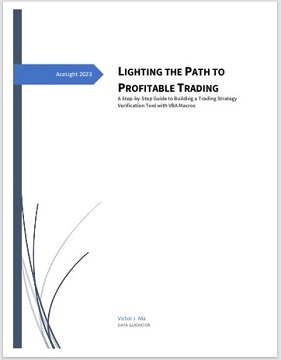Algorithmic Trading Strategies: Basics of Algorithm, Concepts and Examples
|
|
Are you tired of spending hours analyzing the stock market, only to end up
making less profit than a lemonade stand on a rainy day? Do you wish there
was a way to trade without relying on your gut instincts or your Magic
8-Ball? Well, fear not, dear reader, for the solution to your trading woes
may be closer than you think. Say hello to algorithmic trading, where your
emotions and intuition are replaced with cold, hard computer logic. It's
like having a robot as your personal financial advisor, except without the
awkward small talk. So, put down that crystal ball and buckle up, because
we're about to take a ride through the world of algorithmic trading.
Algorithmic trading is the use of computer algorithms to make trading
decisions and execute trades automatically, without human intervention.
These algorithms are typically based on mathematical models that analyze
market data to identify patterns, trends, and trading opportunities.
Algorithmic trading is used by financial institutions and professional
traders to execute trades more quickly, efficiently, and accurately than
would be possible manually. It can involve a range of different strategies,
including statistical arbitrage, trend following, and mean reversion.
Algorithmic trading has become increasingly popular in recent years due to
advances in technology and the availability of high-speed data feeds, which
enable traders to react quickly to changing market conditions.
Algorithmic trading works by using computer algorithms to analyze market
data, identify trading opportunities, and execute trades automatically. The
process typically involves the following steps:
1. Market data
collection: The algorithm collects data on various financial instruments,
such as stocks, futures, and currencies, from different sources, including
market data feeds, news outlets, and social media.
2. Analysis and
modeling: The algorithm uses statistical models and machine learning
algorithms to analyze the data, identify patterns, and predict future market
movements.
3. Strategy development: Based on the analysis, the
algorithm develops a trading strategy, which includes rules for entering and
exiting trades, risk management, and position sizing.
4. Order
execution: The algorithm automatically sends orders to the market, based on
the trading strategy, using an electronic trading platform or an application
programming interface (API).
5. Monitoring and optimization: The
algorithm continuously monitors the market and its performance, and makes
adjustments to the trading strategy as necessary, to optimize returns and
minimize risks.
Algorithmic trading can be used for a wide range of
trading strategies, from simple ones, such as trend following and mean
reversion, to complex ones, such as high-frequency trading and statistical
arbitrage. The effectiveness of algorithmic trading depends on the quality
of the data, the accuracy of the models, and the efficiency of the trading
infrastructure.
Here's a simple example of how algorithmic trading
might work:
Let's say you're a trader who wants to profit from
short-term price movements in a particular stock. You create an algorithm
that uses a technical analysis indicator, such as the MACD, to identify
short-term trends in the stock's price.
The MACD (Moving Average
Convergence Divergence) indicator is a popular technical analysis tool used
by traders to identify trends and momentum in a stock's price. Here's an
example of how an algorithmic trading strategy based on the MACD might work:
1. Collect market data: The algorithm collects historical market data on
a particular stock, including the stock's price, volume, and other
indicators.
2. Calculate MACD: The algorithm calculates the MACD by
subtracting the 26-day exponential moving average (EMA) from the 12-day EMA.
3. Calculate signal line: The algorithm then calculates the signal line,
which is a 9-day EMA of the MACD.
4. Define entry and exit rules: The
algorithm then defines rules for entering and exiting trades based on the
MACD and signal line. For example, the algorithm might send a buy order when
the MACD crosses above the signal line, indicating a bullish trend, and a
sell order when the MACD crosses below the signal line, indicating a bearish
trend.
5. Place trades: Once the rules are defined, the algorithm can
automatically place trades based on the signals generated by the MACD
indicator.
6. Monitor and optimize: The algorithm can continuously
monitor the performance of the trading strategy and adjust its parameters,
such as the length of the moving averages or the stop loss levels, to
optimize returns and minimize risks.
For instance, suppose the MACD
crosses above the signal line, generating a buy signal. The algorithm could
then send a buy order for the stock. If the MACD then crosses below the
signal line, generating a sell signal, the algorithm would send a sell order
to close the position.
This is just a simple example, but it
illustrates how algorithmic trading can be used with technical analysis
indicators like the MACD to automate trading decisions and execute trades
more quickly and efficiently than would be possible manually.
Algorithmic trading offers several advantages over traditional manual
trading, including:
1. Speed: Algorithmic trading can execute trades
much faster than manual trading, which can be crucial in fast-moving markets
where prices can change rapidly.
2. Accuracy: Algorithmic trading can
eliminate the potential for human error in trading, which can result in
better accuracy and fewer mistakes.
3. Efficiency: Algorithmic
trading can be more efficient than manual trading because it can
continuously monitor the market and execute trades automatically based on
predefined rules, which can reduce the time and effort required for trading.
4. Consistency: Algorithmic trading can help ensure consistency in
trading decisions by following a predetermined set of rules and criteria.
5. Reduced costs: Algorithmic trading can reduce the costs associated
with manual trading, such as commissions and fees, by minimizing the need
for human intervention.
6. Backtesting: Algorithmic trading can be
backtested using historical data to evaluate the effectiveness of a trading
strategy before implementing it in real-time trading. Why is this part so
important? Please take a look at this tutorial -
LIGHTING THE PATH TO PROFITABLE TRADING: A Step-by-Step Guide to Building a Trading Strategy Verification Tool with VBA Macros,
it is free.
7. 24/7 trading: Algorithmic trading can be programmed to
operate 24/7, enabling traders to take advantage of opportunities in markets
that operate in different time zones.
Algorithmic trading also has
some potential disadvantages that traders should be aware of, including:
1. Technical issues: Algorithmic trading is reliant on technology and
can be susceptible to technical failures or malfunctions, which can result
in significant losses.
2. Overreliance on historical data:
Algorithmic trading relies on historical data to inform trading decisions,
which can lead to overreliance on past performance and a failure to adapt to
changing market conditions.
3. Lack of human oversight: Algorithmic
trading can operate without human intervention, which can lead to a lack of
oversight and potential errors or unintended consequences.
4.
Regulatory challenges: Algorithmic trading can be subject to regulatory
challenges, such as restrictions on high-frequency trading or increased
scrutiny of algorithmic trading strategies.
5. Competitive landscape:
Algorithmic trading has become increasingly popular, and the market is now
highly competitive, which can make it difficult for traders to achieve a
sustained competitive advantage.
6. Data quality: Algorithmic trading
relies on high-quality, accurate data to inform trading decisions, which can
be challenging to obtain in certain markets or under certain conditions.
Algorithmic trading can be applied to a wide range of trading
strategies, but certain strategies are particularly well-suited to
algorithmic trading. Here are some examples:
1. Trend-following
strategies: Algorithmic trading can be used to identify and follow trends in
the market, such as moving average crossovers, Bollinger Bands, or momentum
indicators.
2. Mean-reversion strategies: Algorithmic trading can be
used to identify and exploit deviations from the mean, such as through pairs
trading or statistical arbitrage.
3. News-based strategies:
Algorithmic trading can be used to analyze news and other market data to
identify trading opportunities, such as event-driven strategies or sentiment
analysis.
4. High-frequency trading: Algorithmic trading can be used
to execute trades quickly and efficiently, making it well-suited to
high-frequency trading strategies, such as market-making or statistical
arbitrage.
5. Options trading strategies: Algorithmic trading can be
used to identify and execute options trading strategies, such as
delta-neutral or volatility arbitrage strategies.
6. Machine
learning-based strategies: Algorithmic trading can be used with machine
learning techniques to analyze and identify patterns in market data and make
trading decisions based on predictive models.
 Ultimately, the most
effective trading strategies for algorithmic trading will depend on a
variety of factors, including the trader's goals and risk tolerance, the
characteristics of the market being traded, and the available data and
technology. It's important to carefully evaluate and test different trading
strategies before implementing them in real-time trading. Ultimately, the most
effective trading strategies for algorithmic trading will depend on a
variety of factors, including the trader's goals and risk tolerance, the
characteristics of the market being traded, and the available data and
technology. It's important to carefully evaluate and test different trading
strategies before implementing them in real-time trading.
And
there you have it, folks! Algorithmic trading: the ultimate way to make
money without ever having to leave your computer chair or put on pants. With
the power of technology on your side, you'll be trading like a pro in no
time. So, say goodbye to the stress and anxiety of manual trading, and hello
to the sweet, sweet sound of your algorithm making you money while you
binge-watch Netflix. Who needs a yacht when you have an algorithm, am I
right? Just remember to keep an eye on your robot overlords, and don't
forget to update your anti-virus software. Happy trading!
Click
LIGHTING THE PATH TO PROFITABLE TRADING: A Step-by-Step Guide to Building a Trading Strategy Verification Tool with VBA Macros to get the whole tutorial handbook for free!
And click Free Trial to download strategies testing tools, all for a 30-day Free Trial.
Click on Subscription to order more strategies testing tools to help your stock trading.
|


|

Free Tutorial
Share
|
|
|
|